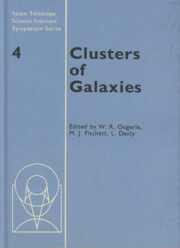Book contents
- Frontmatter
- Contents
- Preface
- Participants
- Chapter 1 Cosmology and Cluster Formation
- Chapter 2 Clusters of Galaxies: Structure, Infall, and Large-Scale Distribution
- Chapter 3 Cosmogony with Clusters of Galaxies
- Chapter 4 Cosmogony and the Structure of Rich Clusters of Galaxies
- Chapter 5 The Dark Matter Distribution in Clusters
- Chapter 6 The Effect of the Cluster Environment on Galaxies
- Chapter 7 Evidence for Gas Deficiency in Cluster Galaxies
- Chapter 8 Properties of Galaxies in Groups and Clusters
- Chapter 9 Dynamical Evolution of Clusters of Galaxies
- Chapter 10 Hot Gas in Clusters of Galaxies
- Chapter 11 Hydrodynamic Simulations of the Intracluster Medium
- Chapter 12 Evolution of Clusters in the Hierarchical Scenario
- Chapter 13 Distant Clusters as Cosmological Laboratories
- Chapter 14 Future Key Optical Observations of Galaxy Clusters
- Chapter 15 Cluster Research with X-ray Observations
- Plate section
Chapter 1 - Cosmology and Cluster Formation
Published online by Cambridge University Press: 06 July 2010
- Frontmatter
- Contents
- Preface
- Participants
- Chapter 1 Cosmology and Cluster Formation
- Chapter 2 Clusters of Galaxies: Structure, Infall, and Large-Scale Distribution
- Chapter 3 Cosmogony with Clusters of Galaxies
- Chapter 4 Cosmogony and the Structure of Rich Clusters of Galaxies
- Chapter 5 The Dark Matter Distribution in Clusters
- Chapter 6 The Effect of the Cluster Environment on Galaxies
- Chapter 7 Evidence for Gas Deficiency in Cluster Galaxies
- Chapter 8 Properties of Galaxies in Groups and Clusters
- Chapter 9 Dynamical Evolution of Clusters of Galaxies
- Chapter 10 Hot Gas in Clusters of Galaxies
- Chapter 11 Hydrodynamic Simulations of the Intracluster Medium
- Chapter 12 Evolution of Clusters in the Hierarchical Scenario
- Chapter 13 Distant Clusters as Cosmological Laboratories
- Chapter 14 Future Key Optical Observations of Galaxy Clusters
- Chapter 15 Cluster Research with X-ray Observations
- Plate section
Summary
Abstract. I discuss some issues that arise in the attempt to understand what rich clusters of galaxies might teach us about cosmology. First, the mean mass per galaxy in a cluster, if applied to all bright galaxies, yields a mean mass density ∼ 30 percent of the critical Einstein-de Sitter value. Is this because the mass per galaxy is biased low in clusters, or must we learn to live in a low density universe? Second, what is the sequence of creation? There are theories in which protoclusters form before galaxies, or after, or the two are more or less coeval. Third, can we imagine that clusters formed by gravitational instability out of Gaussian primeval density fluctuations? Or do the observations point to the non-Gaussian perturbations to be expected from cosmic strings, or explosions, or even some variants of inflation? These issues depend on a fourth: do we know the gross physical properties of clusters well enough to use them as constraints on cosmology? I argue that some are too well established to ignore. Their implications for the other issues are not so clear, but one can see signs of progress.
THE STATISTICS OF CLUSTERS OF GALAXIES
To draw lessons for cosmology, we need not only the physical properties of individual clusters but also an understanding of how typical the numbers are. The issue here is whether the Abell catalog or any other now available is adequate for the purpose.
- Type
- Chapter
- Information
- Clusters of Galaxies , pp. 1 - 24Publisher: Cambridge University PressPrint publication year: 1990
- 1
- Cited by

